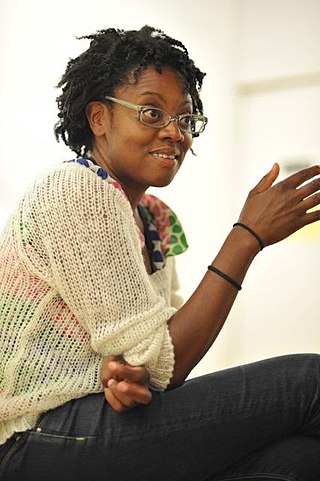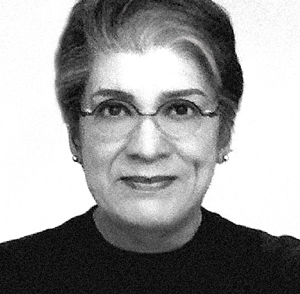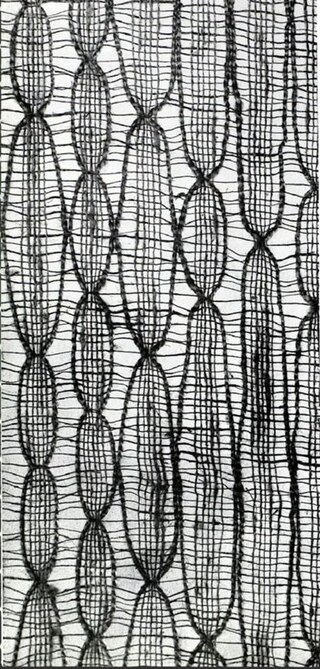
Mary Lee Hu is an American artist, goldsmith, and college educator, known for using textile techniques to create intricate woven wire jewelry.

Sonya Clark is an American artist of Afro-Caribbean heritage. Clark is a fiber artist known for using a variety of materials including human hair and combs to address race, culture, class, and history. Her beaded headdress assemblages and braided wig series of the late 1990s, which received critical acclaim, evoked African traditions of personal adornment and moved these common forms into the realm of personal and political expression. Although African art and her Caribbean background are important influences, Clark also builds on practices of assemblage and accumulation used by artists such as Betye Saar and David Hammons.

Cauleen Smith is an American born filmmaker and multimedia artist. She is best known for her feature film Drylongso and her experimental works that address the African-American identity, specifically the issues facing black women today. Smith is currently a professor in the Department of Art at the University of California - Los Angeles.
Harmony Hammond is an American artist, activist, curator, and writer. She was a prominent figure in the founding of the feminist art movement in 1970s New York.

Judithe Hernández is an American artist and educator, she is known as a muralist, pastel artist, and painter. She is a pioneer of the Chicano art movement and a former member of the art collective Los Four. She is based in Los Angeles, California and previously lived in Chicago.

Tom Joyce is a sculptor and MacArthur Fellow known for his work in forged steel and cast iron. Using skills and technology acquired through early training as a blacksmith, Joyce addresses the environmental, political, and social implications of using iron in his work. Exhibited internationally since the 1980s, his work is included in 30-plus public collections in the U.S. and abroad. Joyce works in Santa Fe, New Mexico producing sculpture, drawings, prints, photographs, and videos that reference themes of iron in the human body, iron in industry, and iron in the natural world.
Sheila Pepe is an artist and educator living and working in Brooklyn, New York. She is a prominent figure as a lesbian cross-disciplinary artist, whose work employs conceptualism, surrealism, and craft to address feminist and class issues. Her most notable work is characterized as site-specific installations of web-like structure crocheted from domestic and industrial material, although she works with sculpture and drawing as well. She has shown in museums and art galleries throughout the United States.

Joyce J. Scott is an African-American artist, sculptor, quilter, performance artist, installation artist, print-maker, lecturer and educator. Named a MacArthur Fellow in 2016, and a Smithsonian Visionary Artist in 2019, Scott is best known for her figurative sculptures and jewelry using free form, off-loom beadweaving techniques, similar to a peyote stitch. Each piece is often constructed using thousands of glass seed beads or pony beads, and sometimes other found objects or materials such as glass, quilting and leather. In 2018, she was hailed for working in new medium — a mixture of soil, clay, straw, and cement — for a sculpture meant to disintegrate and return to the earth. Scott is influenced by a variety of diverse cultures, including Native American and African traditions, Mexican, Czech, and Russian beadwork, illustration and comic books, and pop culture.

Kay Sekimachi is an American fiber artist and weaver, best known for her three-dimensional woven monofilament hangings as well as her intricate baskets and bowls.

Jefferson Pinder is an African-American performance artist whose work provokes commentary about race and struggle.

Lia Cook is an American fiber artist noted for her work combining weaving with photography, painting, and digital technology. She lives and works in Berkeley, California, and is known for her weavings which expanded the traditional boundaries of textile arts. She has been a professor at California College of the Arts since 1976.
Wendy Maruyama is an American visual artist, furniture maker, and educator from California. She was born in La Junta, Colorado.

Amber Cowan is an American artist and educator living and working in Philadelphia. Cowan creates fused and flameworked glass sculptures from cullet and recycled industrial glass.
Beatrice Sophia Steinfeld Levy was an American printmaker and painter, draftsman, and instructor.
Margo Hoff was an American painter.

Michael Janis is an American artist currently residing in Washington, DC where he is one of the directors of the Washington Glass School. He is known for his work on glass using the exceptionally difficult sgraffito technique on glass.
Susana Raab is an American fine art and documentary photographer based in Washington, D.C. She was born in Lima, Peru.
Joan Livingstone is an American contemporary artist, educator, curator, and author based in Chicago. She creates sculptural objects, installations, prints, and collages that reference the human body and bodily experience.
Katie Hudnall is an American artist known for her woodworking. Hudnall teaches at the University of Wisconsin–Madison having previously taught at the Herron School of Art and Design in Indianapolis.
Betty Scarpino is an American wood sculptor active in Indianapolis, Indiana. She received the Windgate International Turning Exchange Resident Fellowship two times - once in 1999 and another in 2016 - making her the second person in the residency's history to be chosen twice. In 2020, she was awarded an Honorary Lifetime Member from the American Association of Woodturners (AAW) for her contributions to the advancement of woodturning. Her work is currently in the Smithsonian American Art Museum's collection and The Center for Art in Wood Museum's collection.












